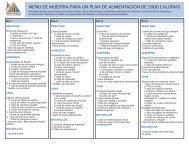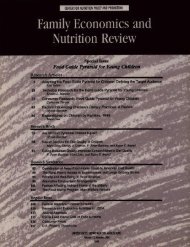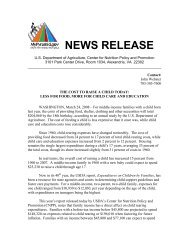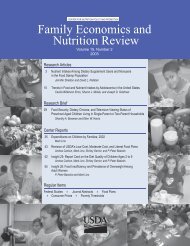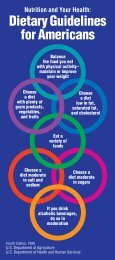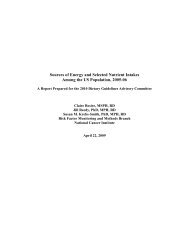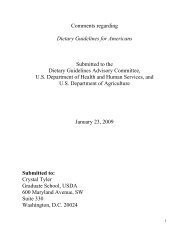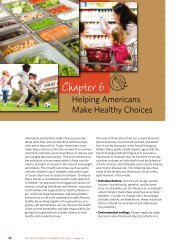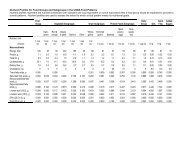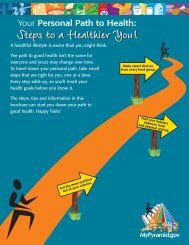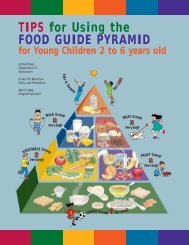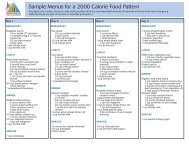Elderly Nutrition - Center for Nutrition Policy and Promotion - US ...
Elderly Nutrition - Center for Nutrition Policy and Promotion - US ...
Elderly Nutrition - Center for Nutrition Policy and Promotion - US ...
You also want an ePaper? Increase the reach of your titles
YUMPU automatically turns print PDFs into web optimized ePapers that Google loves.
these cognitive dem<strong>and</strong>s (Buzzard &<br />
Sievert, 1994). Hence, the National<br />
<strong>Center</strong> <strong>for</strong> Health Statistics (NCHS)<br />
has cited the need <strong>for</strong> additional<br />
research in this area (U.S. <strong>Center</strong>s<br />
<strong>for</strong> Disease Control, 1994). A better<br />
underst<strong>and</strong>ing of cognitive strategies<br />
(i.e., the ways in which people access<br />
<strong>and</strong> recall in<strong>for</strong>mation) used during<br />
the recall process could help to design<br />
survey questions <strong>and</strong> interview<br />
procedures—<strong>and</strong> improve recall.<br />
These strategies, however, are not<br />
well understood, especially in older<br />
population groups. Recent in<strong>for</strong>mation<br />
suggests that adults age 18 to 65 use<br />
various cognitive strategies when<br />
recalling portion sizes of foods eaten<br />
the previous day (Chambers, Godwin,<br />
& Vecchio, 2000). Underst<strong>and</strong>ing the<br />
cognitive strategies <strong>for</strong> estimating<br />
portion size is important in<strong>for</strong>mation<br />
to have when developing effective<br />
estimation methods <strong>for</strong> procedures<br />
such as the 24-hour dietary recall,<br />
a technique used in many nutrition<br />
studies. Currently, there is little in<strong>for</strong>mation<br />
about the cognitive strategies<br />
used by the elderly <strong>and</strong> how accurately<br />
they estimate portion sizes.<br />
It is unclear whether using aids to help<br />
respondents estimate portion sizes<br />
increases accuracy <strong>for</strong> the elderly.<br />
Although these aids have the potential<br />
to provide an accurate, convenient<br />
means of estimating food portions,<br />
some research has indicated the<br />
accuracy of estimations may not<br />
improve with certain foods when aids<br />
are used (Godwin et al., 2001). The<br />
purpose of this research, there<strong>for</strong>e, was<br />
to gain a better underst<strong>and</strong>ing of the<br />
process that elderly respondents use to<br />
estimate portion sizes <strong>and</strong> to determine<br />
if aids used to estimate portion sizes<br />
improve these respondents’ accuracy<br />
in saying how much they had eaten.<br />
Methods<br />
Phase I<br />
Four highly trained interviewers<br />
conducted one-on-one interviews with<br />
118 respondents age 65 years or older.<br />
Respondents were recruited from existing<br />
consumer-testing databases; by<br />
referral from associates; <strong>and</strong> through<br />
advertisements posted in health<br />
departments, churches, schools, <strong>and</strong><br />
businesses. Of the 118 respondents,<br />
75 percent were women; 65 percent<br />
were White, 32 percent were Black,<br />
<strong>and</strong> 3 percent were of other racial<br />
origins.<br />
Because strategies <strong>for</strong> estimating<br />
portion size could be affected by the<br />
aids shown to participants, four sets of<br />
aids were used, with about 30 respondents<br />
assigned to each specific set.<br />
The aids represented various 2- <strong>and</strong> 3-<br />
dimensional aids <strong>for</strong> estimating portion<br />
sizes that have been used in the CSFII<br />
<strong>and</strong> NHANES studies as well as new<br />
aids that have been available to<br />
nutritionists, such as a book of photographs<br />
of portion sizes (Hess, 1997).<br />
The first set consisted primarily of<br />
2-dimensional aids in a booklet that<br />
included full-size drawings of bowls,<br />
cups, plates, <strong>and</strong> glasses; three diagrams<br />
of geometric shapes—a muffinshaped<br />
grid, cylindrical diagram, <strong>and</strong><br />
circles; <strong>and</strong> a tool <strong>for</strong> estimating<br />
portions of wedges. Actual measuring<br />
cups <strong>and</strong> spoons <strong>and</strong> a ruler also were<br />
included.<br />
The second set included mostly<br />
3-dimensional aids such as actual<br />
bowls, cups, plates, glasses, measuring<br />
cups <strong>and</strong> spoons, bean bags in four<br />
sizes, a ruler, <strong>and</strong> sticks <strong>for</strong> estimating<br />
thickness. Also included in this set<br />
were a muffin diagram, the cylindrical<br />
diagram, <strong>and</strong> the tool <strong>for</strong> estimating<br />
portions of wedges. The third set<br />
included photographs (Hess, 1997)<br />
of portions of 35 representative foods<br />
(e.g., cooked mixed vegetables<br />
were used to represent any cooked<br />
vegetable), a ruler, the muffin <strong>and</strong><br />
cylindrical diagrams, the wedge tool,<br />
<strong>and</strong> measuring cups <strong>and</strong> spoons. The<br />
fourth set included photographs (Hess,<br />
1997) of household vessels (e.g., bowls,<br />
cups, plates, <strong>and</strong> glasses), a ruler, the<br />
muffin <strong>and</strong> cylindrical diagrams, the<br />
wedge tool, <strong>and</strong> measuring cups <strong>and</strong><br />
spoons. During interviews, the aids<br />
from one of the four sets were arranged<br />
r<strong>and</strong>omly in front of respondents, to<br />
avoid having the position of the aid<br />
create bias.<br />
We used the respondents’ age, gender,<br />
<strong>and</strong> race to balance their assignment<br />
to a test group of portion-size aids.<br />
Interviewers were trained to use any of<br />
the portion-size aid sets in an interview.<br />
To enable researchers to categorize the<br />
cognitive processes used in remembering<br />
portion sizes, respondents used a<br />
think-aloud process (Ericsson & Simon,<br />
1984) during the interview, with them<br />
verbally describing their strategies <strong>for</strong><br />
deciding how much of each food they<br />
ate. To facilitate the procedure <strong>and</strong> to<br />
help respondents underst<strong>and</strong> the task<br />
<strong>and</strong> become acquainted with the<br />
procedure, we asked each respondent<br />
to complete two practice think-aloud<br />
activities—arranging five cards of<br />
various shapes from smallest to largest<br />
<strong>and</strong> matching colors to shapes. Respondents<br />
were reminded to think aloud if<br />
they were not doing so—to verbalize<br />
everything they were thinking. If a<br />
respondent hesitated, the interviewer<br />
asked nonsuggestive questions that<br />
would help the person describe his<br />
or her thought process.<br />
Procedures <strong>for</strong> the initial dietary interview<br />
were adapted from those used<br />
in the CSFII (Tippett & Cypel, 1998).<br />
The multi-pass approach we used gave<br />
respondents several opportunities to<br />
provide details about the foods they had<br />
consumed. In the first pass, respondents<br />
were asked to recall foods they<br />
2003 Vol. 15 No. 1 59



